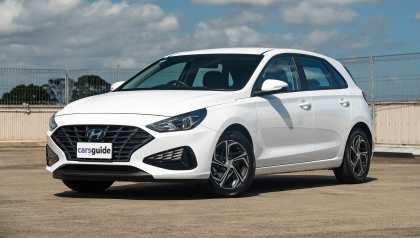As the tortoise taught the hare - slow and steady wins the race.
Kia has been making slow but steady upwards progress on the sales charts ever since it introduced its industry-leading seven-year warranty in 2014. Back then Kia was very much Hyundai’s younger sibling, sitting well outside the top 10 brands in sales. Fast forward to 2021 and Kia finished May in third place, behind only Toyota and Mazda, and crucially, ahead of Hyundai.
The reason for this success? They are many and varied, but a big one is Kia having models in every major passenger segment. Notably small cars, a segment where many of its rivals have pulled back in favour of a greater focus on SUVs.
Kia, though, has maintained a heavy presence in small cars while expanding its SUV range (witness the new Stonic and Niro), and as a result the Cerato has become its best-selling model and the third best-selling small car in the country. It has managed to pick up sales as rivals become less competitive or simply disappear.
But it’s not just picking up the crumbs of its rivals, the Cerato is a good small car and for 2021 Kia has tried to make it better with a raft of changes. We sampled the updated Cerato range to see how it stacks up.
Kia Cerato 2021: GT Safety Pack
| Engine Type | Turbo 4, 1.6L |
|---|---|
| Fuel Type | Unleaded Petrol |
| Fuel Efficiency | 6.8L/100km (combined) |
| Seating | 5 |
| Price From | $26,180 - $32,340 |
| Safety Rating |
|
Does it represent good value for the price? What features does it come with?
8 / 10
A big part of the appeal of the Cerato is the breadth of the range, with both sedan and hatch options as well as four different trim lines - S, Sport, Sport+ and GT. While most of the range is powered by a 2.0-litre engine, the GT gets a 1.6-litre turbocharged unit and a more sophisticated suspension package to help establish it as the premium option.
What they all have in common is a strong value argument, thanks to generous equipment and Kia’s focus on keeping the pricing competitive but affordable; ignoring the temptation of some rivals to delete cheaper entry-level models in favour of more profitable high-grade variants.
Pricing for the range has leaped up with this change though, with the cost-of-entry into the Cerato now $3800 higher than the out-going model because Kia Australia has opted to axe the cheaper manual-equipped variants.
Kia does offer drive-away pricing across the range, and charges the same for hatch and sedan to keep it simple. The S is still highly competitive in the small car segment, priced from $25,990 drive-away, and the Sport is priced from $27,990. Both the S and Sport are available with the optional 'Safety Package' for an extra $1500.

Next up is the Sport+, from $31,690 drive-away, with the GT topping the line-up at $36,990 drive-away.
The S gets the basics such as 16-inch steel wheels with plastic hubcaps, cloth trimmed seats, front and rear parking sensors and cruise control as before, but for this update adds new LED daytime running lights, an upgraded multimedia system and some extra safety features.
In addition to those items the Cerato Sport comes with new look 17-inch alloy wheels, a new 10.2-inch media screen, digital radio, navigation and 'sport pattern' cloth trim.
The Sport+ takes things up another notch, adding keyless entry and start, dual-zone climate control and leather-appointed seats as well as heated front seats to add a bit of luxury. Another new-for-2021 addition is an electric park brake, which also means larger rear brake discs for improving stopping power.

The range-topping GT is actually a fairly different proposition to the rest of the Cerato range, with its turbocharged engine and other sporty elements designed to turn it into a ‘warm hatch’ like the Hyundai i30 N Line or Ford Focus ST-Line.
So, as well as a more potent engine, the GT gets 18-inch alloy wheels, LED headlights and tail-lights and a unique body kit with more aggressive lines for a sportier look. It also gets more premium touches in the cabin, including an eight-speaker JBL sound system, a wireless charging pad as well as a sunroof and ventilated front leather seats; the latter pair are new additions to this updated model.
The S features the same 8.0-inch multimedia screen as previously, but adds wireless Apple CarPlay and Android Auto functionality. The rest of the range gets Kia’s latest media system and a larger 10.2-inch touchscreen.
While this system misses out on wireless smartphone connectivity, it does get navigation (with 10 years of map and live traffic updates) as well as the ‘Sounds of Nature’ function that plays various types of white noise (lapping waves, rainforest sounds, etc) that have been designed to soothe children or relax adults.
Is there anything interesting about its design?
7 / 10
Kia has made a number of subtle changes to the Cerato for this update - and one major one. The Cerato is the first model to feature Kia’s new logo, with the stylised ‘KIA’ replacing the previous lettering within an oval. It may sound small but it stands out dramatically on the front and rear of the Cerato.
The brand is introducing this new logo around the world as it bids to rejuvenate its image as it moves further into the mainstream. It also comes as Kia looks to make itself a more contemporary brand with a range of electrified vehicles set to join the line-up in the coming months and years (or, in the case of the e-Niro, already).
The front end of both the hatch and sedan have been redesigned to freshen up the look of the Cerato. The grille is new and blends into the headlights, which have also been changed, while the lower bumper has been restyled with the fog lights now integrated into the air intake for what the company hopes is a sleeker look.
At the back end, Kia focused its efforts on the sedan by adding new tail-lights and a new bumper to create a smoother, more flowing design from the side; the hatch is unchanged. Also at the rear, Kia has tried to create a visual difference between the two engine choices, with the S, Sport and Sport+ now getting hidden exhaust pipes, while the GT gets a new design with twin exhaust tips.
Another visual change is the new look 17-inch alloy wheels for the Sport and Sport+ models, which look quite sharp for a sub-$30K hatch (at least in the case of the Sport).
How practical is the space inside?
7 / 10
A hallmark of Kia’s interior design is how thoughtful and usable the layouts typically are. There are a few minor changes for this updated Cerato, but given how well received the previous model was it didn’t need a major overhaul.
The thoughtful touches include plenty of small item storage space and cupholders, but also three new USB ports including one in the back for rear passengers to charge up their devices. Whereas some brands put USB ports in illogical spots, Kia’s are positioned next to a place to store your phone (or other device) which adds to the practical nature of the cabin.
One notable change from the old model is the introduction of rear air-conditioning vents across the range, which will make the back seat more comfortable than the old model.
The seats in the S, Sport and Sport+ are good, because while they lack the lateral support of the GT seats, they are comfortable, even on our longer stints behind the wheel.
Space in the back is adequate for a small car. I’m approximately 180cm (5'11") tall and can fit behind my own driving position in the rear without my knees touching the back of the front seat, so the Cerato could take four adults in relative comfort. However, like most small cars the back seats are better suited to smaller children.
The boot space obviously varies between the hatch and sedan. The former has 428-litres of room and offers a wide space for loading your luggage. The four-door Cerato offers up even more boot space, 502-litres. That’s more than what a Holden Commodore offered a decade ago, which is one reason why small cars have remained popular.
What are the key stats for the engine and transmission?
7 / 10
As mentioned earlier, there are two powertrains to choose from, one for the S, Sport and Sport+ and a separate one for the GT. With the exception of Kia’s decision to drop the manual gearbox, what you find under the bonnet is unchanged from the pre-facelifted model.
The S, Sport and Sport+ are powered by a 2.0-litre four-cylinder petrol engine, producing 112kW of power and 192Nm of torque. It sends that power to the front wheels via a six-speed automatic transmission, exclusively now the manual has been dropped.
The GT is powered by a 1.6-litre turbo-petrol four-cylinder unit that offers more punch - 150kW/265Nm, to be precise. It also gets a unique transmission, a seven-speed dual-clutch automatic, but is front-wheel drive like the rest of the range.
How much fuel does it consume?
6 / 10
The 2.0-litre naturally-aspirated four-cylinder engine isn’t really at the cutting-edge of small car technologies, but while it does the job it means fuel economy isn’t a match of the best-in-class.
Officially the 2.0-litre models (hatch and sedan) are rated at 7.4-litres per 100km on the combined urban/highway cycle, which is unchanged from the previous model.
However, there’s a slight difference between the GT hatch and sedan. The five-door has a claimed return of 6.8L/100km, which is the same as before, but the four-door has actually had a minor increase to 6.9L/100km (up from 6.8L/100km). Kia puts this change down to the adoption of a new catalytic converter.
On test we saw returns of 8.2L/100km in the S and 8.3L/100km in the GT, but those trips didn’t include any significant highway mileage so it’s unsurprising they’re higher than claimed. We spent a more representative time behind the wheel of a Sport, which included highway and dynamic, country road driving and saw a return of 7.9L/100km, which is in the ballpark of the official claim.
Warranty & Safety Rating
What safety equipment is fitted? What safety rating?
7 / 10
This is one area that has come in for significant attention during this update, with several new safety items added across the range. However, the Cerato retains the same split safety crash rating from ANCAP (it’s worth noting these are carry-over scores from when the previous model was tested in 2019), with the S and Sport scoring four stars while the Sport+ and GT have maximum five-star scores.
The reason for this is simple and deeply confusing. Put simply, the S/Sport miss out on some key safety features as standard - specifically, blind spot detection, rear cross-traffic alert and autonomous emergency braking (AEB) with cyclist avoidance - which means they’re unable to achieve the maximum rating.

However, Kia does offer both models with a Safety Package that includes those items for an additional $1500, thus meaning they achieve the same five-star score as the Sport+/GT if you’re willing to pay extra.
Where it gets a bit confusing is Kia had to drop the manual transmission because of the safety ratings. That’s because the manual wasn’t compatible with the full AEB system, which means it couldn’t be fitted with the Safety Pack and therefore could only ever be a four-star car. For reasons that require a separate story, ANCAP rules mean that the entire range would have been classified as four-stars, so the manual was axed.

What’s actually important is the safety equipment the cars do have. In the case of the S/Sport that means AEB with car and pedestrian detection, lane keep assist, lane follow assist, driver attention alert and speed warning. In addition to the previously mentioned items, the Safety Package also adds 'Safe Exit Warning' (which is standard on the Sport+/GT) that uses sensors to detect if you’re opening your door into oncoming traffic or cyclists.
The Sport+/GT also get two new active safety items - blind-spot collision avoidance assist and rear cross-traffic alert with collision avoidance assist. These are extensions of existing warning systems that add autonomous braking to mitigate or avoid a potential collision.
In terms of passive safety, all Ceratos are fitted with six airbags (driver and front passenger, front side, and dual curtain) and come with three child seat anchor points and a pair of ISOFIX locations.
What does it cost to own? What warranty is offered?
8 / 10
Kia is now famous for its seven year/unlimited kilometre warranty, and the brand freely admits it has played a major role in its sales growth, acting as an incentive to entice new customers to take a chance on the brand.
It’s also backed up with a seven-year capped price servicing plan and seven years of roadside assistance, making the Cerato ownership experience class-leading in many respects.
In terms of servicing, intervals for the 2.0-litre are every 12 months or 15,000km while the GT, with its unique powertrain, needs 12 month/10,000km check ups.

Unlike some companies that offer a flat rate or at least a consistent rate for minor and major service, the cost of each Cerato service varies significantly. For example, the first service for the 2.0-litre costs $275, the second $469 and the third $339. Over the full seven year period the average cost works out at $419 per year.
It’s the same story for the 1.6-litre, with the 10,000km visit costing you $282, and the 20,000km $476, before the 70,000km visit hits $640; which is at the high end for a mainstream small car. Over the full period though, the GT isn’t significantly more to service, averaging $470 annually over the seven years.
What's it like to drive?
7 / 10
There’s a lot more that's different between the majority of the range and the GT than just the powertrain. Underneath the S/Sport/Sport+ get a different suspension layout (a torsion team axle instead of a multi-link set-up in the GT, for the technically inclined), which has an impact on ride and handling.
The good news is the Cerato was already a nice small car to drive, having been put through Kia Australia’s local ride and handling program that adjusts the suspension and steering systems to better suit our local roads.
Kia opted not to change it for the S/Sport/Sport+ with this facelift, happy with what it had - and after our test drive that's clearly a good decision. While not as dynamic as some small cars, the Cerato is pleasant to drive, around town and on the open road, thanks to its good balance between ride comfort and responsive handling.

It steers nicely and always feels responsive and well controlled, even if you push on a little bit in some twisty corners. But really, most Ceratos will spend their lives around town, and it feels easy to live with negotiating traffic.
The 2.0-litre engine does its job adequately, but lacks the off-the-mark surge you get from rivals with smaller capacity turbocharged engines (like the GT). It’s good, offering enough performance to allow the Cerato to keep up with traffic, but you do need to work it harder at times to keep it in its sweet spot.
The GT might have some hot hatch elements (and the engine is the same one the Hyundai i20 N will use) but it’s definitely not one. Instead, think of it as a ‘warm hatch’ (or sedan if you prefer) that has some sporty elements, but also a few more premium touches for those who want a small car that feels more luxurious and well-appointed than city runabouts of years gone by.
The engine obviously offers more performance than the 2.0-litre, without ever really moving into hot hatch territory. The dual-clutch transmission also delivers faster shifts than the automatic in the other models, but it isn’t always as smooth.

The more-sophisticated suspension set-up does mean the GT feels nicer to drive than the 2.0-litre models, plus Kia Australia re-tuned the shock absorbers as part of this facelift. They worked to make the ride more comfortable without sacrificing handling. It’s fair to say they succeeded, the GT remains more engaging and responsive than the other models in the range.
All models are impressively quiet for a small car, with good insulation making it feel a bit more polished than your average small car.
One area Kia needs to work on is the tuning of the active lane keeping system. Like most recent Kia models (and Hyundais as they share the same technology) it can be too intrusive, often tugging the wheel in your hands when it doesn’t need to. There is a button on the wheel to turn it off, but hopefully Kia (and Hyundai) will improve the tuning for future models as lane keeping assist can be a useful safety tool when done right.
Verdict
The point of the tortoise and hare story is that the tortoise didn't pretend to be something it isn't. It stuck to its strategy and emerged victorious at the end. It’s hard not to think of the Cerato - and Kia as a whole - the same way.
The Cerato isn't trying to be a premium small car, like the Mazda3 or Volkswagen Golf, it’s just a simple, straightforward small car. It's honest, dependable and easy to drive, which makes it a good value proposition for many buyers. It’s easy to understand why it has become so popular.
In terms of picking the sweet spot of the range, while the GT is certainly well-appointed and faster, the entry-level S with Safety Package is our preferred choice. It offers the best value, giving you all the elements you really need, even if you do miss out on the shiny alloy wheels, while still offering a pleasant driving experience.































.jpg)
.jpg)














.png)
.jpg)
.jpg)
_3.webp)
.jpg)



.jpg)
.jpg)

Comments